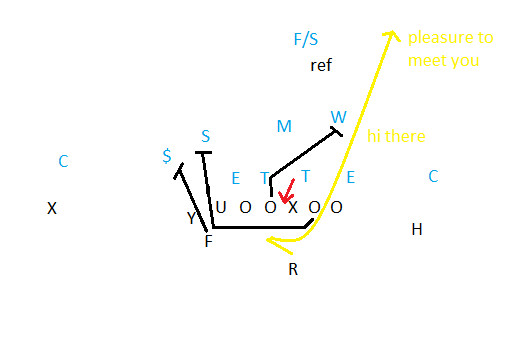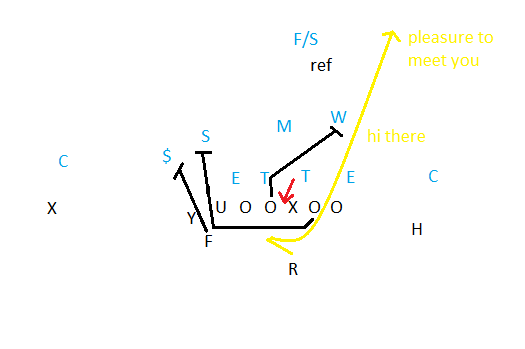What was the best part of Stanford’s domination of UCLA last Thursday? It’s hard to pick just one, but let’s go with this …
You know how I said that Stanford was running different run plays than Power lately? Stanford hammered UCLA so badly on Power that even when UCLA knew it was coming, they couldn’t stop it. Stanford ran Power again and again and again, and that means one thing: The Cardinal offensive line made the UCLA front seven look like … well, I’m sure you can come up with the right euphemisms yourself.
Christian McCaffrey was brilliant, making plays where ordinary backs would have let drives collapse; he also surfed to victory behind waves and waves of red, and it’s not like acknowledging the brilliance of one unit casts a pall upon the other. Everything was clicking in the Stanford run game today, and every one of McCaffrey’s touchdowns was scored with good old smashmouth football. First touchdown? Isolation. Second? Power. Third? Power. Fourth? Power again, after running Power for something like five straight plays.
The Stanford offensive line has played very well this season, but there’s a difference between playing well and bashing an opponent back to the Stone Age. Stanford hasn’t manhandled an opponent so thoroughly since … ever? Like Buck Nasty’s suit in “The Playa Haters’ Ball,” UCLA left Stanford Stadium bombed out and depleted.
And speaking of haters … let me introduce you to the Wildcat.
David Shaw has spent the last three years sniping at people who hate the Wildcat (no-quarterback) offense, and people keep on sniping back. I don’t particularly like the Wildcat myself, because Stanford’s not going to win games without being able to throw the ball.
But there are some advantages to the Wildcat formation. Stanford is running many of the same plays (trick plays excepted, of course), but substituting an extra run blocker for Kevin Hogan allows the Cardinal to capitalize on bad defending. And when Stanford already has a big advantage in run blocking, why not make it overwhelming?
Let’s take a look at Christian McCaffrey’s third touchdown (video here). All his touchdowns are prime examples of the offensive line manhandling people, but I think this one is the funniest.
This is a fairly standard Power play. Regular readers have seen this a thousand times. So let’s try to find out something interesting that I haven’t covered before.
First off, because the Wildcat is not built to run an advanced passing game, you’re almost always going to see single-safety coverages against the Wildcat. The defense will keep at least one player deep as long as Stanford has a receiver split wide that can get open reasonably often — and Devon Cajuste (X) is a good threat. That means if the offense can make a hole in the front eight, the defense has very little margin for error. Additionally, with Bryce Love (H) in the game, the Cardinal still have two run threats, which compensates for the loss of Kevin Hogan’s legs.
The Wildcat also shakes up defenses by confusing them. The extra blocker must be accounted for — in football lingo, he creates an “extra gap.” But UCLA doesn’t get an extra blocker without giving up its final safety. Long story short, Stanford has eight blockers against eight men in the box. Unless somebody gets whipped or Stanford gets out-schemed, there’s nobody in the box to tackle McCaffrey. And Stanford players weren’t getting whipped very often.
In other words…the Wildcat doesn’t introduce anything particularly new to the scheme, but it massively changes the complexion of the game. Stanford’s just running its base offense in the Wildcat formation. But defenses are often used to playing 11-on-9 in the running game, and so playing 11-on-10 doesn’t always come easily to them.
UCLA revealed its unpreparedness for the Wildcat on both the playside and the backside of McCaffrey’s long touchdown run. On the playside, UCLA’s lined up in a rather perplexing manner — the three skill position blockers (Y, U, F) are opposite only two immediate defenders ($ and S). UCLA is basically relying on its middle linebacker (M) and deep safety (F/S) to save the day wherever the play goes. UCLA did a decent enough job of filling the hole on Power, but Stanford’s blocks were solid enough that if McCaffrey had run the play as planned and cut to the outside, he would have gotten a nice gain anyway before the safety caught up to him.
Second, a massive cutback lane opens up for McCaffrey. Once Stanford pulls a guard for Power, UCLA has a numbers advantage on the backside. But left guard Josh Garnett does a combo block with left tackle Kyle Murphy on UCLA’s strong-side defensive tackle and the two basically run him over — so convincingly, in fact, that Garnett is able to release to second level of the defense almost immediately. It’s like the tackle wasn’t even there — that was how dominant Stanford was at the core blocks.
When Garnett gets contact with UCLA’s weak-side linebacker (W), only the free safety is left to tackle McCaffrey. And to add insult to injury (because there was plenty of both for UCLA on Thursday night), the safety trips as he tries to avoid the ref. Random things like that happen in sports. Stanford puts its players in position to capitalize on it.
Do we normally see cutbacks on Power? No. But with a little help from the refs — see what I did there? — McCaffrey found a cutback lane the size of L.A. County. A cutback, David Shaw explained a few years ago, “is like a $20 bill. If you’re walking down the block and you see a $20, you should take it, but if you spend your whole life walking around looking at the ground as you go hoping to see a $20 bill, you’ll most likely get hit by a bus.”
Well, we know who got hit by a metaphorical bus on Thursday, and it wasn’t Stanford. Sweet dreams, everybody.
Contact Winston Shi at wshi94 ‘at’ stanford.edu.

